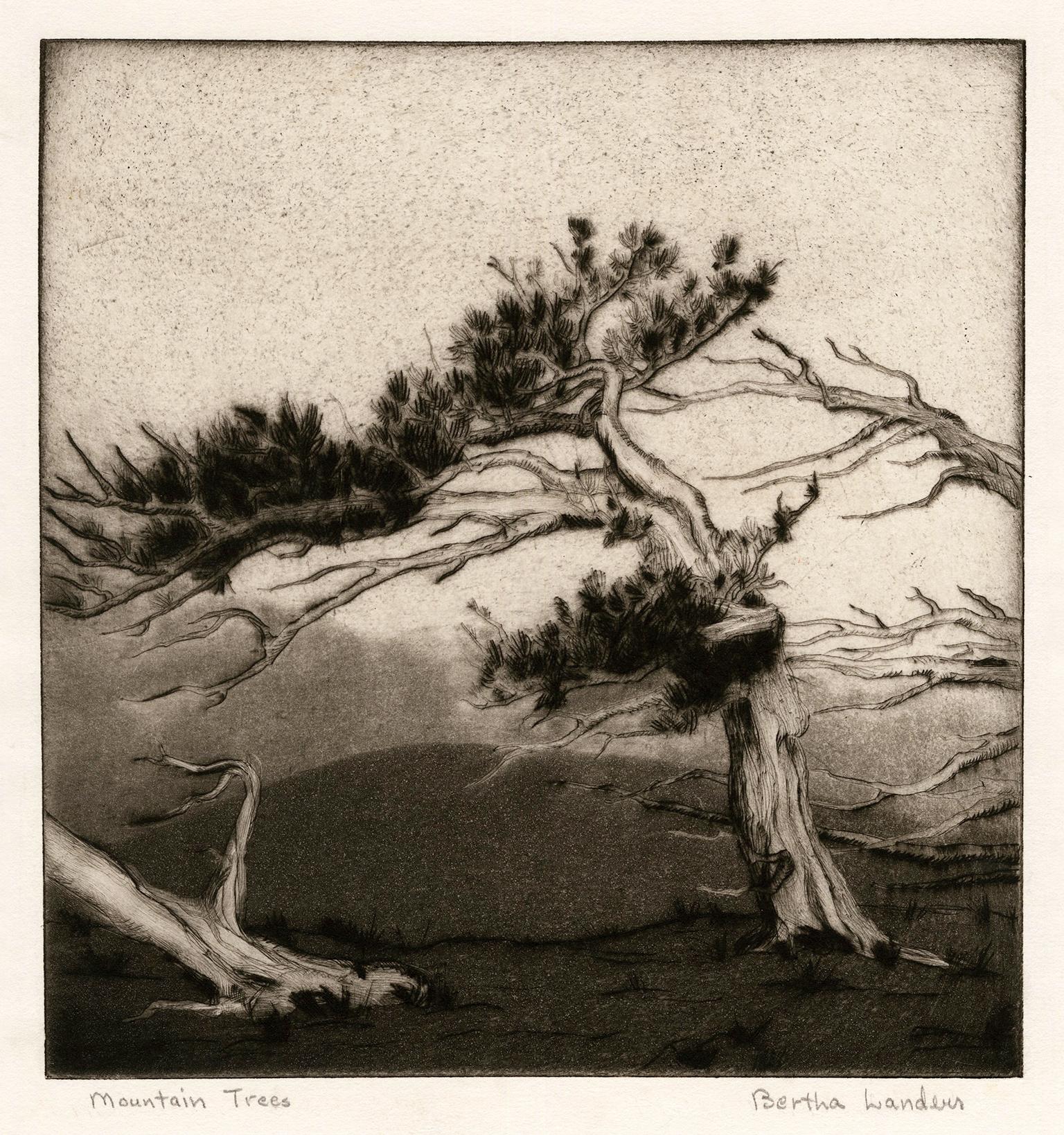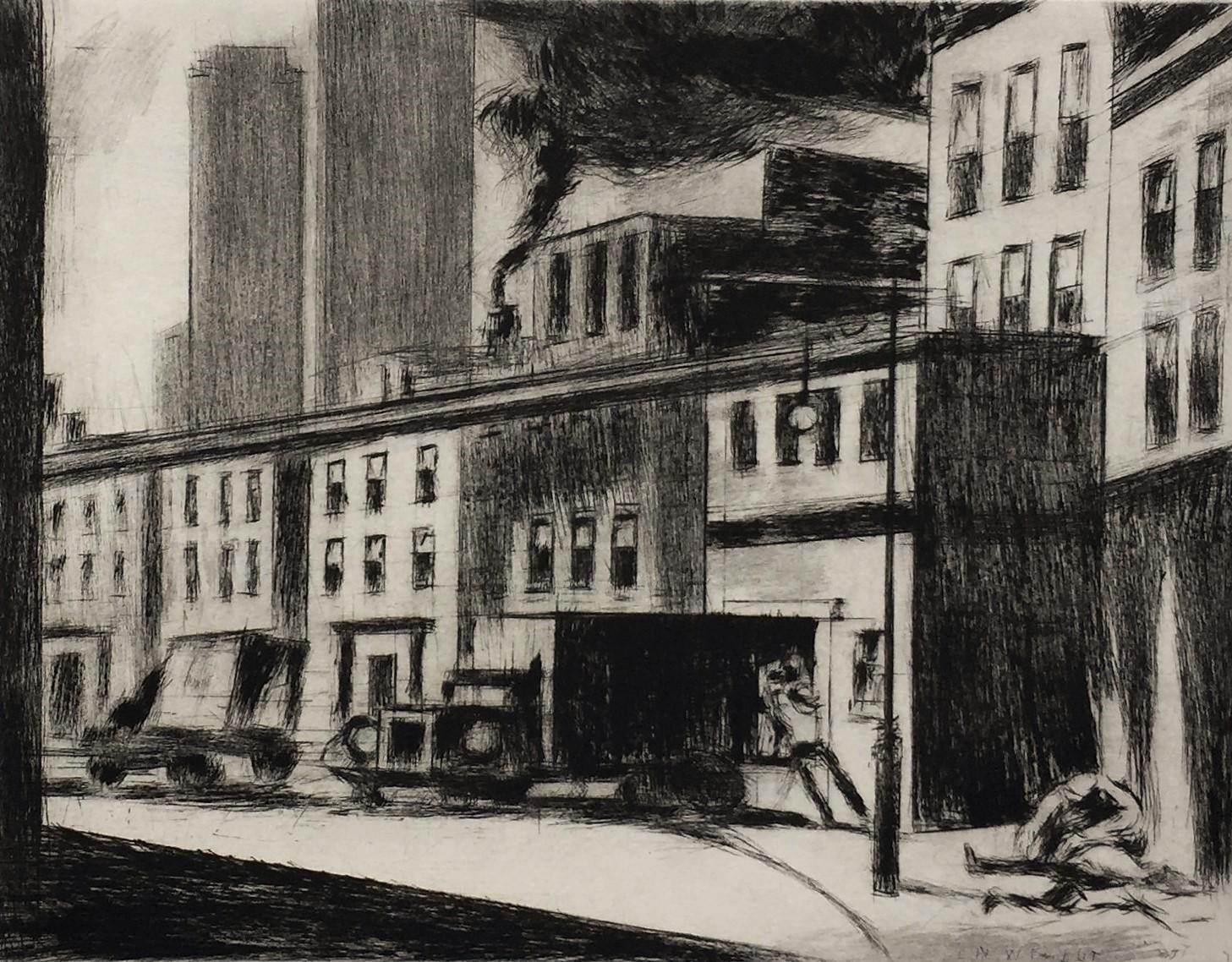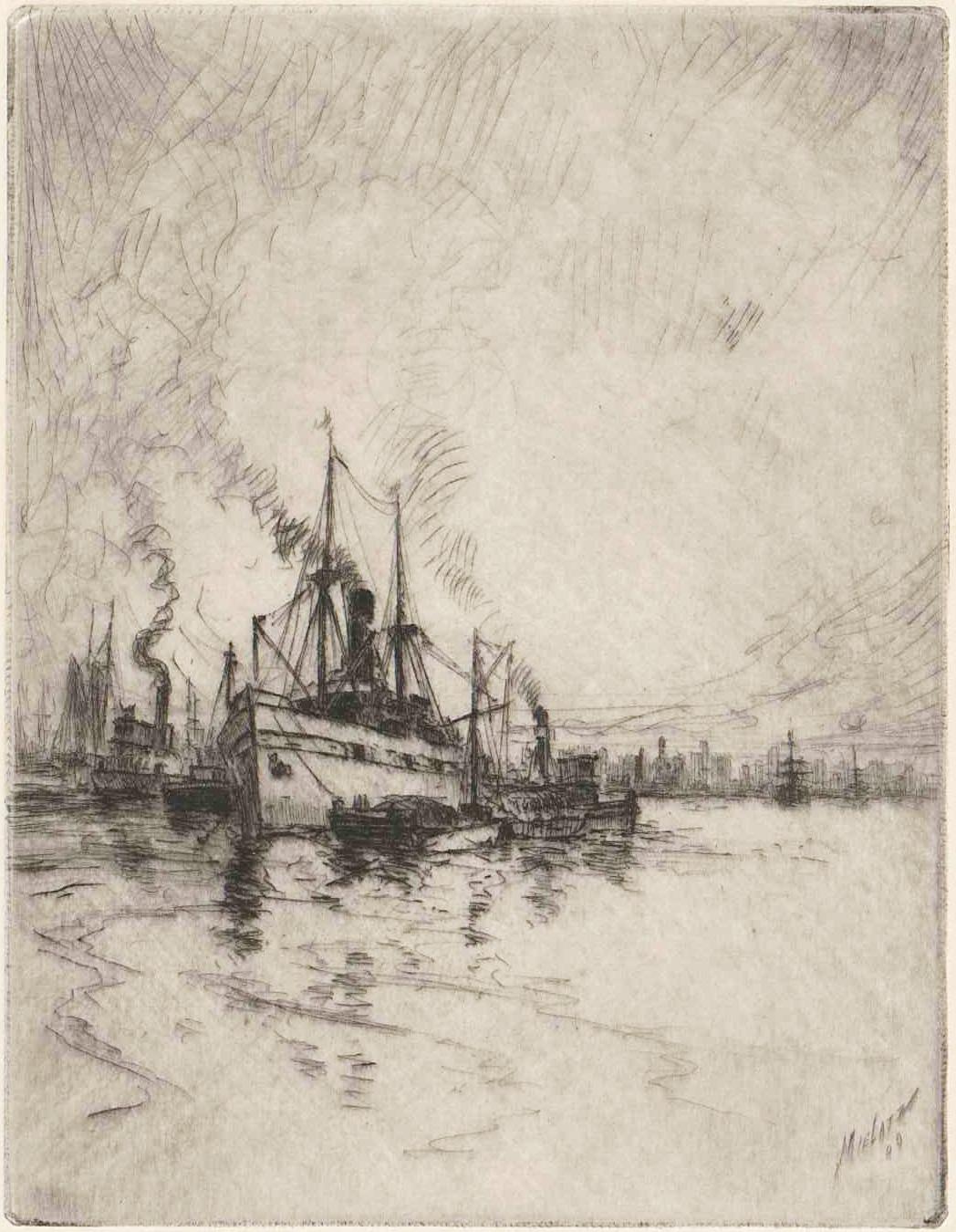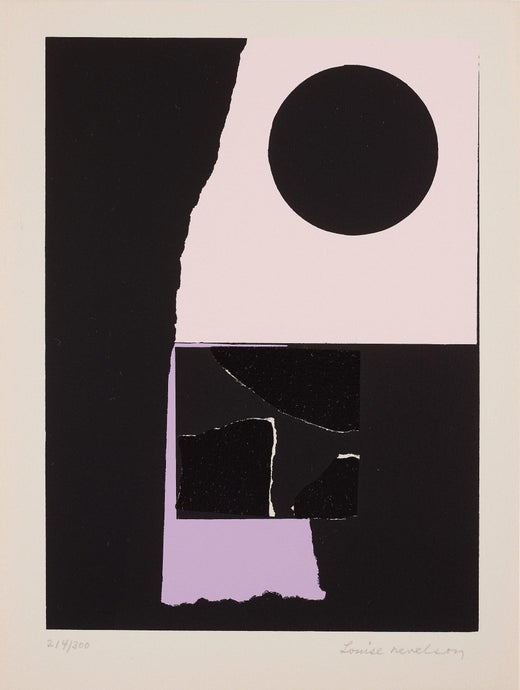Louise NevelsonAncient Landscape II (Ancient City)1953-55
1953-55
About the Item
- Creator:Louise Nevelson (1899 - 1988, American)
- Creation Year:1953-55
- Dimensions:Height: 13.63 in (34.63 cm)Width: 20.75 in (52.71 cm)
- Medium:
- Movement & Style:
- Period:
- Condition:
- Gallery Location:Fairlawn, OH
- Reference Number:
Louise Nevelson
Louise Nevelson was one of the leading American female sculptors of the 20th century, and she did it on her own terms. She was a pioneer of installation art and created large-scale monochromatic sculptures that are today known for their provocative, compartmentalized forms. While her assemblages involved a range of materials, she is best known for her wooden sculptures. Working in a single color was her signature, and all-encompassing color demanded an all-encompassing focus for this artist — she even kept separate studios for work in black, white and gold.
Nevelson was born in what is now Ukraine in 1899 and emigrated to the United States with her family in 1905. She moved to New York City as a young woman in 1920 to study at the Art Students League. In the 1930s, Nevelson traveled around Europe, came into contact with the works of Picasso, studied with Hans Hofmann and assisted Diego Rivera in New York City.
Nevelson had her first solo show in 1941 at the Nierendorf Gallery in New York. In the late 1940s, she studied with Stanley William Hayter and worked as a ceramicist in the workshop of revered furniture designer Vladimir Kagan, who let her take scraps from the factory to use in her sculptures. (As a child, Nevelson had also worked with discarded wood from her father's lumber yard.)
By the early 1950s, Nevelson had traveled to Guatemala and Mexico. She was inspired by pre-Columbian art and the totemic works of ancient cultures. Nevelson began creating the first of her iconic wood sculptures and later participated in the legendary “Sixteen Americans” exhibition at the Museum of Modern Art. Her work was acquired by prominent institutions in the years that followed.
Nevelson made reliefs in shadow boxes and was for a time affiliated with New York City’s Sidney Janis Gallery as its first female Abstract Expressionist artist (her work was abstract but she also drew on the Cubist and Constructivist movements). In the early 1960s, Nevelson showed her art in Chicago, Manhattan, Paris and West Germany. It was around this time that she exhibited at Pace Gallery in Boston and New York. The gallery represented her for the duration of her career.
Nevelson died in 1988, but her legacy is immense. Her work is held in virtually every major American art museum, including the Museum of Modern Art, the Metropolitan Museum of Art, the Los Angeles County Museum of Art and the National Gallery of Art. Her permanent large-scale public sculptures are installed all over the country, including in Louise Nevelson Plaza in New York City's Financial District.
On 1stDibs, find original Louise Nevelson sculptures, prints and drawings.
- ShippingRetrieving quote...Ships From: Akron, OH
- Return PolicyA return for this item may be initiated within 10 days of delivery.
- Western Hills Viaduct Under ConstructionBy Louis Conrad RosenbergLocated in Fairlawn, OHWestern Hills Viaduct Under Construction Drypoint, June 1931 Signed in pencil lower right (see photo) Initialed and dated in the plate lower right above pencil signature (see photo) From: Cincinnati Series, 1930-1931, 8 plates, this No. 5 Small edition, not specified From Greenfield Hill Condition: Excellent Image/Plate size: 8 1/2 x 15 1/4 inches Sheet size: 11 1/4 x 18 1/2 inches Louis Conrad Rosenberg 1890-1983 An American architectural etcher...Category
1930s American Modern Landscape Prints
MaterialsDrypoint
- Cincinnati Union Terminal, Perspective From EastBy Louis Conrad RosenbergLocated in Fairlawn, OHCincinnati Union Terminal, Perspective From East Drypoint, 1930-1931 Signed in pencil lower right (see photo) Initialed and dated the the plate above the pencil signature From: Cincinnati Series (8 Plates), this No. 2 Edition: 155, completed May 4, 1931 Delivered to Fellheimer & Wagner, 1931 Louis Conrad Rosenberg 1890-1983 An American architectural etcher and engraver of the 1920's and 1930's era, Louis Conrad Rosenberg first studied at the Massachusetts Institute of Technology...Category
1930s American Modern Landscape Prints
MaterialsDrypoint
- Ontario St. Grading and Temporary RampsBy Louis Conrad RosenbergLocated in Fairlawn, OHOntario St. Grading and Temporary Ramps Drypoint, August 1929 Signed in pencil lower right (see photo) From: The Cleveland Set (23 plates), this being No. 13 Edition: Small A brilliant example of American industrial art. A wonderful, rich impression, with lots of burr and contrasts. Louis Conrad Rosenberg 1890-1983 An American architectural etcher and engraver of the 1920's and 1930's era, Louis Conrad Rosenberg first studied at the Massachusetts Institute of Technology. He then enrolled at the Royal College of Art, London, to study etching techniques under Malcolm Osborne...Category
1920s American Modern Landscape Prints
MaterialsDrypoint
- Trout Fishing on the Gunnison (Colorado)By Adolf DehnLocated in Fairlawn, OHTrout Fishing on the Gunnison (Colorado) Lithograph, 1941 Signed and dated '42 in pencil lower right Annotated lower left: "40 Prints-The Gunnison River, Colorado-For Anne & Jack" Ed...Category
1940s American Modern Landscape Prints
MaterialsLithograph
- New York NightBy Adolf DehnLocated in Fairlawn, OHNew York Night\Lithograph, 1930 Edition: 30 Printer: Meister Schulz, Berlin Printed on heavy wove paper without watermark This lithograph was created in...Category
1930s American Modern Landscape Prints
MaterialsLithograph
- Brooklyn WaterfrontBy Adolf Arthur DehnLocated in Fairlawn, OHBrooklyn Waterfront Lithograph, 1931 Signed, titled, and dated in pencil by the artist Edition: Undetermined (very small), plus artist's proofs Printed by Meister Schulz, Berlin Provenance: Estate of the artist Virginia Dehn, the artist's widow Dehn Quests Bibliography: Lumsdaine and O'Sullivan 152 Illustrated: Adams, The Sensuous Life of Adolf Dehn, Fig. 9.14, page 213 (This impression) Adolf Dehn, American Watercolorist and Printmaker, 1895-1968 Adolf Dehn was an artist who achieved extraordinary artistic heights, but in a very particular artistic sphere—not so much in oil painting as in watercolor and lithography. Long recognized as a master by serious print collectors, he is gradually gaining recognition as a notable and influential figure in the overall history of American art. In the 19th century, with the invention of the rotary press, which made possible enormous print runs, and the development of the popular, mass-market magazines, newspaper and magazine illustration developed into an artistic realm of its own, often surprisingly divorced from the world of museums and art exhibitions, and today remains surprisingly overlooked by most art historians. Dehn in many regards was an outgrowth of this world, although in an unusual way, since as a young man he produced most of his illustrative work not for popular magazines, such as The Saturday Evening Post, but rather for radical journals, such as The Masses or The Liberator, or artistic “little magazines” such as The Dial. This background established the foundation of his outlook, and led later to his unique and distinctive contribution to American graphic art. If there’s a distinctive quality to his work, it was his skill in introducing unusual tonal and textural effects into his work, particularly in printmaking but also in watercolor. Jackson Pollock seems to have been one of many notable artists who were influenced by his techniques. Early Years, 1895-1922 For an artist largely remembered for scenes of Vienna and Paris, Adolf Dehn’s background was a surprising one. Born in Waterville, Minnesota, on November 22, 1895, Dehn was the descendent of farmers who had emigrated from Germany and homesteaded in the region, initially in a one-room log cabin with a dirt floor. Adolf’s father, Arthur Clark Dehn, was a hunter and trapper who took pride that he had no boss but himself, and who had little use for art. Indeed, during Adolf’s boyhood the walls of his bedroom and the space under his bed were filled with the pelts of mink, muskrats and skunks that his father had killed, skinned and stretched on drying boards. It was Adolf’s mother, Emilie Haas Dehn, a faithful member of the German Lutheran Evangelical Church, who encouraged his interest in art, which became apparent early in childhood. Both parents were ardent socialists, and supporters of Eugene Debs. In many ways Dehn’s later artistic achievement was clearly a reaction against the grinding rural poverty of his childhood. After graduating from high school in 1914 at the age of 19—an age not unusual in farming communities at the time, where school attendance was often irregular—Dehn attended the Minneapolis School of Art from 1914 to 1917, whose character followed strongly reflected that of its director, Munich-trained Robert Kohler, an artistic conservative but a social radical. There Dehn joined a group of students who went on to nationally significant careers, including Wanda Gag (later author of best-selling children’s books); John Flanagan (a sculptor notable for his use of direct carving) Harry Gottlieb (a notable social realist and member of the Woodstock Art Colony), Elizabeth Olds (a printmaker and administrator for the WPA), Arnold Blanch (landscape, still-life and figure painter, and member of the Woodstock group), Lucille Lunquist, later Lucille Blanch (also a gifted painter and founder of the Woodstock art colony), and Johan Egilrud (who stayed in Minneapolis and became a journalist and poet). Adolf became particularly close to Wanda Gag (1893-1946), with whom he established an intense but platonic relationship. Two years older than he, Gag was the daughter of a Bohemian artist and decorator, Anton Gag, who had died in 1908. After her husband died, Wanda’s mother, Lizzi Gag, became a helpless invalid, so Wanda was entrusted with the task of raising and financially supporting her six younger siblings. This endowed her with toughness and an independent streak, but nonetheless, when she met Dehn, Wanda was Victorian and conventional in her artistic taste and social values. Dehn was more socially radical, and introduced her to radical ideas about politics and free love, as well as to socialist publications such as The Masses and The Appeal to Reason. Never very interested in oil painting, in Minneapolis Dehn focused on caricature and illustration--often of a humorous or politically radical character. In 1917 both Dehn and Wanda won scholarships to attend the Art Students League, and consequently, in the fall of that year both moved to New York. Dehn’s art education, however, ended in the summer of 1918, shortly after the United States entered World War I, when he was drafted to serve in the U. S. Army. Unwilling to fight, he applied for status as a conscientious objector, but was first imprisoned, then segregated in semi-imprisonment with other Pacifists, until the war ended. The abuse he suffered at this time may well explain his later withdrawal from taking political stands or making art of an overtly political nature. After his release from the army, Dehn returned to New York where he fell under the spell of the radical cartoonist Boardman Robinson and produced his first lithographs. He also finally consummated his sexual relationship with Wanda Gag. The Years in Europe: 1922-1929 In September of 1921, however, he abruptly departed for Europe, arriving in Paris and then moving on to Vienna. There in the winter of 1922 he fell in love with a Russian dancer, Mura Zipperovitch, ending his seven-year relationship with Wanda Gag. He and Mura were married in 1926. It was also in Vienna that he produced his first notable artistic work. Influenced by European artists such as Jules Pascin and Georg Grosz, Dehn began producing drawings of people in cafes, streets, and parks, which while mostly executed in his studio, were based on spontaneous life studies and have an expressive, sometimes almost childishly wandering quality of line. The mixture of sophistication and naiveté in these drawings was new to American audiences, as was the raciness of their subject matter, which often featured pleasure-seekers, prostitutes or scenes of sexual dalliance, presented with a strong element of caricature. Some of these drawings contain an element of social criticism, reminiscent of that found in the work of George Grosz, although Dehn’s work tended to focus on humorous commentary rather than savagely attacking his subjects or making a partisan political statement. Many Americans, including some who had originally been supporters of Dehn such as Boardman Robinson, were shocked by these European drawings, although George Grocz (who became a friend of the artist in this period) admired them, and recognized that Dehn could also bring a new vision to America subject matter. As he told Dehn: “You will do things in America which haven’t been done, which need to be done, which only you can do—as far at least as I know America.” A key factor in Dehn’s artistic evolution at this time was his association with Scofield Thayer, the publisher of the most notable modernist art and poetry magazine...Category
1920s American Modern Landscape Prints
MaterialsLithograph
- 'Mountain Trees' — 1930s Southwestern RegionalismLocated in Myrtle Beach, SCBertha Landers, 'Mountain Trees', etching and drypoint, c. 1938, edition not stated but small. Signed and titled in pencil. A fine, richly-inked impres...Category
1930s American Modern Landscape Prints
MaterialsDrypoint, Etching
- 'Manhattan Old and New' —1920s Realism, CityscapeBy Samuel ChamberlainLocated in Myrtle Beach, SCSamuel Chamberlain, 'Manhattan Old and New', drypoint, 1929, edition 100, Chamberlain and Kingsland 81. Signed, titled, and numbered '81/100' in pencil. Titled and annotated '30.00' in pencil, in the artist's hand, bottom margin. Matted to museum standards, unframed. A superb, finely-detailed impression, with selectively wiped plate tone, on heavy Rives cream wove paper; full margins (1 1/2 to 2 1/4 inches), in excellent condition. The subject of the print is the lower Manhattan cityscape just before the Depression. Image size 8 3/4 x 6 13/16 inches (222 x 173 mm); sheet size 12 3/4 x 10 inches (324 x 254 mm). Impressions of this work are held in the collections of the National Gallery of Art and the Zimmerli Art Museum. ABOUT THE ARTIST 'There is something about the atmospheric vibrancy of an etching which imparts a peculiar and irresistible life to architectural drawing...A copper plate offers receptive ground to the meticulously detailed drawing which so often appeals to the architect'. —Samuel Chamberlain, from the Catalogue Raisonné of his prints. Samuel V. Chamberlain (1896 - 1975), printmaker, photographer, author, and teacher, was born in Iowa. His family moved to Aberdeen, Washington in 1901, and in 1913, Chamberlain enrolled in the University of Washington in Seattle, where he studied architecture under Carl Gould. By 1915, he was enrolled in the School of Architecture of the Massachusetts Institute of Technology in Boston. With the United States' involvement in the First World War, Chamberlain sailed to France, where he volunteered in the American Field Service. In 1918, he was transferred to the United States Army to complete his tour of duty. After the war, he returned to Boston and resumed his architectural studies, which he eventually discontinued, working for a few years as a commercial artist. Chamberlain received the American Field Service Scholarship in 1923, which he used to travel to Spain, North Africa, and Italy. In 1924 he was living in Paris, where he studied lithography with Gaston Dorfinant and etching and drypoint with Edouard Léon, publishing his first etching the following year. In 1927, he studied drypoint with Malcolm Osborne...Category
1920s American Modern Landscape Prints
MaterialsDrypoint
- 'Soaring Steel' — 1920s Realism, Chicago CityscapeBy Samuel ChamberlainLocated in Myrtle Beach, SCSamuel Chamberlain, 'Soaring Steel', drypoint, 1929, edition 100, Chamberlain and Kingsland 79. Signed, titled, and numbered '64/100' in pencil. Annotated '48.00' in pencil, in the artist's hand, bottom right margin. A superb, finely-detailed impression, with selectively wiped plate tone, on heavy Rives cream wove paper; full margins (1 3/8 to 1 7/8 inches), in excellent condition. Matted to museum standards, unframed. The subject of the print is the construction of the Daily News Building in Chicago, Illinois. Image size 12 1/4 x 9 1/2 inches (311 x 241 mm); sheet size 15 1/2 x 12 3/8 inches (394 x 314 mm). Impressions of this work are held in the collections of the Art Institute of Chicago, Boston Public Library, Crystal Bridges Museum of American Art, Museum of Modern Art, New York Public Library, University of Michigan Museum of Art, Smithsonian American Art Museum, and the Western Australia Museum. ABOUT THE ARTIST 'There is something about the atmospheric vibrancy of an etching which imparts a peculiar and irresistible life to architectural drawing...A copper plate offers receptive ground to the meticulously detailed drawing which so often appeals to the architect'. —Samuel Chamberlain, from the Catalogue Raisonné of his prints. Samuel V. Chamberlain (1896 - 1975), printmaker, photographer, author, and teacher, was born in Iowa. His family moved to Aberdeen, Washington in 1901, and in 1913, Chamberlain enrolled in the University of Washington in Seattle, where he studied architecture under Carl Gould. By 1915, he was enrolled in the School of Architecture of the Massachusetts Institute of Technology in Boston. With the United States' involvement in the First World War, Chamberlain sailed to France, where he volunteered in the American Field Service. In 1918, he was transferred to the United States Army to complete his tour of duty. After the war, he returned to Boston and resumed his architectural studies, which he eventually discontinued, working for a few years as a commercial artist. Chamberlain received the American Field Service Scholarship in 1923, which he used to travel to Spain, North Africa, and Italy. In 1924 he was living in Paris, where he studied lithography with Gaston Dorfinant and etching and drypoint with Edouard Léon, publishing his first etching the following year. In 1927, he studied drypoint with Malcolm...Category
1920s American Modern Landscape Prints
MaterialsDrypoint
- Irving Guyer, Christmas Trees on Second Street (NYC)By Irving GuyerLocated in New York, NYPhiladelphia-born Irving Guyer attended the Art Students League and worked in New York City before moving to California. This print is signed and titled i...Category
1930s American Modern Figurative Prints
MaterialsEtching, Drypoint
- Under the BridgeBy Lawrence WilburLocated in Storrs, CTUnder the Bridge. 1985. Etching and drypoint. 9 1/2 x 12 1/8 (sheet 20 1/16 x 22). Edition 27, #13. Printed on cream wove paper, on the full sheet with deckle edges. A rich impression in excellent condition, housed in an archival folder. The etching has never been matted. Titled and numbered in pencil. by the artist; signed and initialed in pencil by the artist's estate. Provenance: the artist's estate A dramatic view of the lower East Side in New York. Housed in an archival folder awaiting your choice of mat and frame. Painter and printmaker Lawrence Nelson Wilbur...Category
20th Century American Modern Figurative Prints
MaterialsDrypoint, Etching
- Tugs on the HudsonBy Charles Frederick William MielatzLocated in Middletown, NYDrypoint etching with engraving printed in black ink on Japanese mulberry paper, 4 1/2 x 3 3/8 inches (113 x 84 mm), full margins. In superb condition. A beautiful New York City rive...Category
Early 20th Century American Modern Landscape Prints
MaterialsHandmade Paper, Drypoint, Etching






